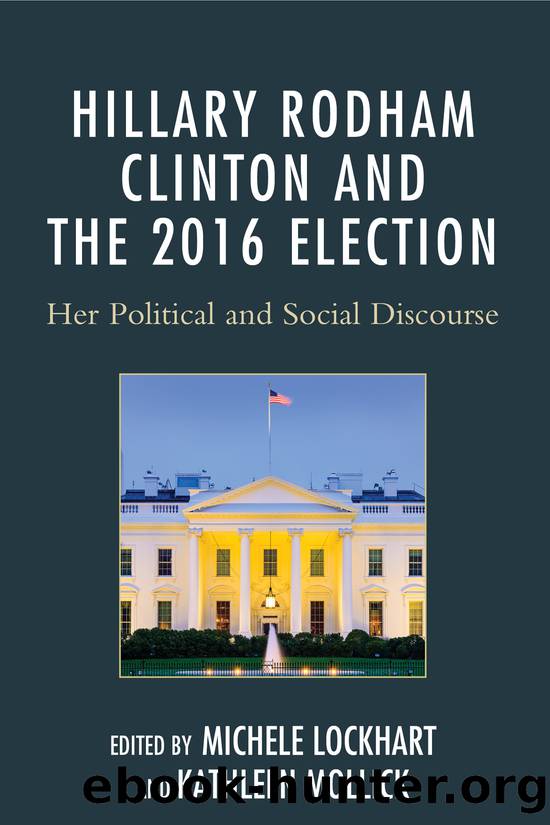Hillary Rodham Clinton and the 2016 Election by unknow

Author:unknow
Language: eng
Format: epub
Publisher: Lexington Books
Chapter 7
Chelseaâs Mom, Charlotteâs Grandma
Negotiating a New Role in the Presidential Construction of Hillary Clinton
Debbie Jay Williams
As Hillary Clinton announced her candidacy for president in 2016, she did so with a âgrandmotherâs glow.â1 Yet her possible bid again raises the issue of the role gender will play in the construction and control of her candidate persona. Much of this struggle for control of identity occurs, Alice Eagly and Steven Karau argue, because characteristics associated with a leader roleâagency, reason, and strengthâare stereotyped as male and may thus be viewed as incompatible with characteristics associated with the female gender roleâbeing emotional, dependent, and nurturing.2 Female candidates thus face a conundrum of how to maintain a feminine identity while being perceived as a competent leader because it appears that one precludes the other. In a study of prejudicial responses to Hillary Clinton and Sarah Palin, Sarah Gervais and Amy Hillard analyze responses to both women to account for this publically perceived incompatibility between âleaderâ and âfemale.â Gervais and Hillard also conclude that a female candidate will struggle when seeking to construct both a positive feminine persona and the persona of a leader competent enough to merit election to public office.3 However, though this research appears to identify public perception as the issue, for Clinton and any other woman who might run in 2016, the issue is one of media portrayal. Deborah Jordan Brooksâ post-2008 quantitative study of public perception of female candidates reveals that the public is actually becoming more open to the possibility of a female president.4 The problem, Brooks notes, is less one of public stereotyping than of journalistsâ negative portrayal of women and perpetuation of gender stereotypes. Brooks offers a warning: âAs a starting point for eliminating the influence of the conventional wisdom about gendered double standards, journalists need to stop perpetuating inaccurate information on this topic . . . The degree to which the media have embraced the conventional wisdom is truly stunning.â5 The issue with the propagation of misinformation by the news media is attributed by Shawn Parry-Giles to the role they seek to play as gatekeepers. Journalists write âboth [as] biographers and character judges,â seeking to reveal a politicianâs or candidateâs true or âauthenticâ persona to the public.6 In the news mediaâs portrayal of politicians, Parry-Giles notes that journalists use perceptions of gender which âbring together ideological forces that can empower yet also bind the nationâs political leaders, [while] offering a gender baseline that fuses with other markers of political authenticity to define an individual leader.â7 Thus, journalists have a great deal of power to perpetuate and maintain socially accepted stereotypes about gender and leadership roles in their portrayal of political figures.
To illustrate this problem in news mediaâs treatment of Hillary Clinton, Parry-Giles uses thick description of television and print media. These media examples highlight the disjunction between Clintonâs pursuit of leadership roles and the news mediaâs expectations of what her gendered behavior should be, a conflict often framed in the language of ârhetorical violence.â8 Parry-Giles
Download
This site does not store any files on its server. We only index and link to content provided by other sites. Please contact the content providers to delete copyright contents if any and email us, we'll remove relevant links or contents immediately.
The Secret History by Donna Tartt(18859)
The Social Justice Warrior Handbook by Lisa De Pasquale(12143)
Thirteen Reasons Why by Jay Asher(8800)
This Is How You Lose Her by Junot Diaz(6802)
Weapons of Math Destruction by Cathy O'Neil(6152)
Zero to One by Peter Thiel(5692)
Beartown by Fredrik Backman(5607)
The Myth of the Strong Leader by Archie Brown(5429)
The Fire Next Time by James Baldwin(5251)
How Democracies Die by Steven Levitsky & Daniel Ziblatt(5133)
Promise Me, Dad by Joe Biden(5088)
Stone's Rules by Roger Stone(5027)
A Higher Loyalty: Truth, Lies, and Leadership by James Comey(4851)
100 Deadly Skills by Clint Emerson(4845)
Rise and Kill First by Ronen Bergman(4705)
Secrecy World by Jake Bernstein(4652)
The David Icke Guide to the Global Conspiracy (and how to end it) by David Icke(4629)
The Farm by Tom Rob Smith(4442)
The Doomsday Machine by Daniel Ellsberg(4420)
